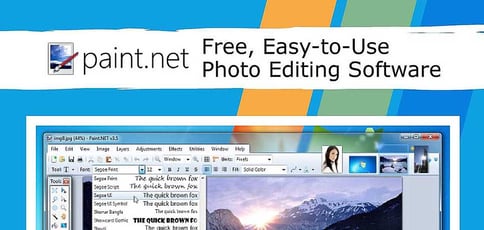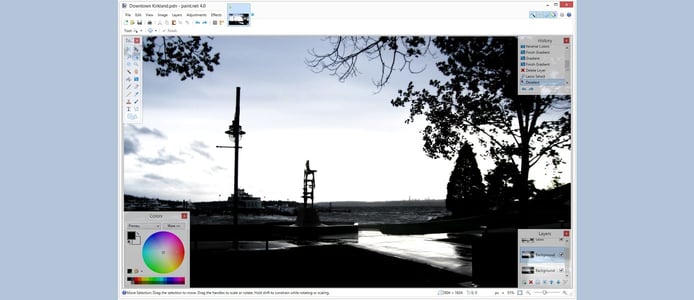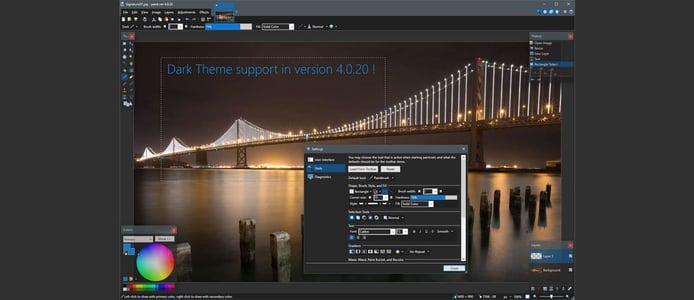
TL; DR: Paint.NET, a free photo editing solution for Windows, is as powerful as it is easy to use. The program’s familiar user interface allows for quick discovery of features, including layers, special effects, and drawing tools. With in-depth tutorials, countless plugin options, and an active and growing online community, Paint.NET delivers a cost-effective alternative to pricey commercial software.
If you grew up in the ’80s or ’90s, there’s a good chance you have a soft spot in your heart for Microsoft Paint. For many, the graphics utility provided an early foray into the world of digital art, allowing imaginations to run wild.
It was in the same lighthearted spirit that in 2004 Founder Rick Brewster and his classmates created Paint.NET while pursuing computer science degrees at Washington State University.
“We weren’t trying to make a product to put on the marketplace with any specific business goal,” Rick said. “It began as a senior design project mentored by Microsoft. We completed Version 1.0 in about 15 weeks and went our separate ways. I kept chipping away at it just because I enjoyed it — I was having fun.”

As a free program, Paint.NET puts photo editing within reach for all users.
Rick grew the program, which was originally intended as a free replacement for the Microsoft Paint software that comes with Windows, into a powerful yet simple image and photo editor tool comparable to Photoshop and GIMP. And he’s been responsible for its maintenance and development ever since.
Today, the software features an intuitive user interface with support for layers and the undo command, special effects, and a wide variety of powerful tools. Users looking to extend to its capabilities can leverage a range of plugins to add effects and support additional file types. With in-depth tutorials and the support of an active and growing online community, Paint.NET is providing Windows users with an affordable and easy-to-use photo editing solution.
A Familiar, Intuitive User Interface with Easily Discoverable Features
Like many freeware programs, Paint.NET experienced a surge in popularity from word-of-mouth marketing alone. But Rick said its mention on Slashdot, a technology news site, caused a dramatic increase in traffic. The effect is so common that tech enthusiasts coined the term “slashdotting” to describe it. “I mentored three students at WSU who helped me release Version 2.0, and then it got slashdotted, which knocked over the server at the school hosting it at the time,” Rick said.
Despite the temporary inconvenience, the experience proved worthwhile. “We got probably 10 times more traffic from then on,” Rick said. “People quickly began to value the platform for its ease of use and feature set.”
Since the beginning, Rick’s goal has been to expand the capabilities of Microsoft Paint through a familiar, Photoshop-like interface with floating tool windows. “You’ve got Photoshop, which you can do anything with, but it’s expensive; then you’ve got GIMP, which is free, but you pay for it in a different way because it’s so difficult to use,” Rick said. “Paint.NET, on the other hand, is free, easy to use, and much more capable than regular Paint.”

Like riding a bike: Many users find the program to be completely intuitive.
Paint.NET has remained free since its initial release in 2004 through donations, as well as support from those who purchase the program from the Windows Store in a display of appreciation. During those 14 years, Rick has seen many trends come and go — but he’s not one to jump on any bandwagons.
For example, when Microsoft introduced the Windows Ribbon Framework in Office 2007, Rick assessed whether to incorporate it into Paint.NET. “I thought it would provide a more scalable user interface in terms of adding new features and making them more discoverable, but ultimately it just wasn’t a good fit because Paint.NET users like to have multiple images or documents open — and that paradigm doesn’t work with the ribbon at all.”
Ultimately, Rick said he’s concluded that simplicity is key. “A complete revamp isn’t always the right move to make,” he said. “It’s best to focus on making sure the user interface is simple, intuitive, and approachable.”
Rich Built-in Tools and Effects with Countless Plugin Options
To that end, Rick’s primary goal is to make Paint.NET’s features easy to find through a familiar user interface. If you’ve used something like Paint or Photoshop, Rick said you should be able to jump into the program and immediately know what to do next.
“I try to make sure that everything is right in front of your face in terms of discoverability,” he said. “If I get email requests from people asking me for features that I already put in the software, that’s a signal that I need to make something more discoverable, and I’ll work on that.”
Paint.NET contains a wide range of built-in features plus support for plugins to extend functionality. The site even features an ever-growing index of downloadable plugins that allow users to add new effects, create custom shapes, adjust images, and support additional file types. “You can do pretty much anything you want if Paint.NET doesn’t handle it already,” Rick said.

Paint.NET is feature-rich with support for a wide range of plugins.
Considering its robust feature set, Rick said the software is remarkably quick to load. Rick understands the importance of startup performance from his experience as a developer.
“It’s a matter of making sure that your train of thought isn’t interrupted because there are too many times where the computer just gets in your way,” he said. “You forget what you’re doing.”
Instead of waiting 30 seconds or so for the program to load, Rick said Paint.NET opens immediately on the average computer. That’s a bonus for quick tasks such as resizing photos or annotating screenshots. It also makes it easy to open and close the program as needed.
“I’m trying to not punish people for making the mistake of closing the program at the wrong time,” Rick said.
Extensive Documentation and a Supportive Community of Online Users
Rick serves as the primary developer behind Paint.NET but enjoys the assistance of an active and growing online community. The Paint.NET site features in-depth documentation on how to make the most out of the user interface, menus, tools, layers, color window, and history palette. From there, the Paint.NET forums deliver tutorials, galleries, downloadable resources, and helpful user discussions.
Those users help by providing bug fixes and even contributing code. “Not everybody’s aware of it, but there’s big online forum with a whole bunch of people participating, trading tips and tricks, and helping each other solve problems,” Rick said. “Some moderators spend a non-trivial amount of time helping out.”
Paint.NET enthusiasts run the gamut from casual users to artists and developers. Rick said younger generations enjoy the freedom to jump in and play around with the program at no cost. Others are professionals looking for a program that’s better than Paint but doesn’t cost a fortune. “There are a large number of game artists and developers who use it, especially in the indie space,” he said.
For example, Developer Eric Barone uses Paint.NET exclusively for the graphics featured in Stardew Valley, a wildly popular indie farming simulation and role-playing game first released on PC in 2016. In just two years, the Zelda-inspired game has sold more than 3.5 million copies.
An Evolving Feature Set Based on the Needs of End Users
When it comes to product development, Rick leans heavily on user feedback. “I don’t do a whole lot of competitive analysis — I primarily listen to end users to learn what they want to do with the program or the features that they’re missing out on,” he said. “Almost all of the features released over the last couple of years were based on user requests.”
After 10 years of working at Microsoft and several years at Facebook, Rick decided to focus exclusively on Paint.NET this year. “That means I’ve gone from having 20% of my time available to about 80%,” he said.
“I’m going to be spending a lot of time preparing infrastructure for the next big wave of features going into Paint.NET.”
To that end, Rick hopes to enhance the user interface with more attractive icons, allow users to install custom brushes, and introduce pen and pressure sensitivity for tablets.
“I didn’t have the time to focus on those big-ticket features previously,” he said. “Now I’m just sitting down and focusing on making Paint.NET perfect.”
With goals like that, Paint.NET is poised to have the same impact on future generations as Paint had on many of us.
HostingAdvice.com is a free online resource that offers valuable content and comparison services to users. To keep this resource 100% free, we receive compensation from many of the offers listed on the site. Along with key review factors, this compensation may impact how and where products appear across the site (including, for example, the order in which they appear). HostingAdvice.com does not include the entire universe of available offers. Editorial opinions expressed on the site are strictly our own and are not provided, endorsed, or approved by advertisers.
Our site is committed to publishing independent, accurate content guided by strict editorial guidelines. Before articles and reviews are published on our site, they undergo a thorough review process performed by a team of independent editors and subject-matter experts to ensure the content’s accuracy, timeliness, and impartiality. Our editorial team is separate and independent of our site’s advertisers, and the opinions they express on our site are their own. To read more about our team members and their editorial backgrounds, please visit our site’s About page.

